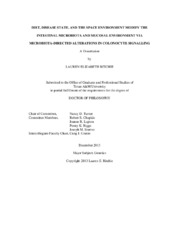| dc.description.abstract | Microbial dysbiosis and toll-like receptor (TLR) signaling play a role in colonic injury and inflammation. Ulcerative colitis and radiation are known to alter microbiota, and diets containing polyphenols impact bacterial populations. We hypothesized that diet can mitigate dextran sodium sulfate (DSS) colitis (sorghum bran diets containing polyphenols) and space environment-induced alterations (normal iron content) in colonic microbiota and TLR signaling. To test this we utilized two experimental paradigms; DSS-induced colitis (3% DSS, 48-hr, 3 exposures, 2 wk separation), and three models to emulate the space environment: 1) fractionated low linear energy transfer (LET) γ radiation (RAD) (3 Gy) and high Fe diet (IRON) (650 mg/kg), 2) high LET Si particle exposure (50 cGy) and 1/6 G hind limb unloading (HLU), and 3) 13 d spaceflight.
Bran diets upregulated proliferation, and repair protein (TFF3 and TGFβ) and short chain fatty acid (SCFA) transporter (Slc16a1 and Slc5a8) expression post-DSS. Diet significantly affected 24-hr fecal butyrate production, with Cellulose and Black bran having numerically higher concentrations. Two predominant phyla were identified, Firmicutes and Bacteroidetes, and this ratio was higher in Cellulose DSS. Post DSS#3 the proportion of Bacteroidales, Clostridiales, and Lactobacillales was reduced compared to post DSS#2 for all diets. Black bran non-DSS rats had the highest richness and diversity. Colonic injury negatively correlated with the proportion of Firmicutes, Actinobacteria, and Lactobacillales, and positively correlated with Unknown and Unclassified groups. Bran diets reduced the severity of epithelial injury, maintained fecal butyrate, and prevented microbial dysbiosis and depletion during DSS-induced colitis.
IRON+RAD decreased SCFA concentrations. Low and high LET radiation, HLU, IRON and spaceflight increased Bacteroidetes and decreased Firmicutes. HLU and spaceflight increased Clostridiales and decreased Lactobacillales. RAD and IRON+RAD animals had increased Lactobacillales and significantly lower Clostridiales compared to CON and IRON. TLR9 and IL-6 were downregulated by RAD. TLR4, TFF3 and TGFβ differentially changed with IRON and spaceflight. Microgravity independently affected the microbiota, regardless of radiation energy or dose.
Each environmental insult differentially altered the microbiota and mucosal gene expression, with distinct diet, microgravity, and radiation effects observed. Bran diets mitigated deleterious effects of colitis, maintained barrier integrity, and prevented microbiota dysbiosis. | en |


